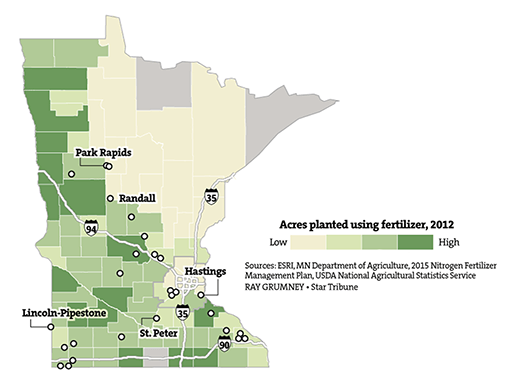Nitrates in Minnesota Well Water

Nitrate in drinking water is considering a growing threat for Minnesota. Nitrate has been in the news, and is the main focus of the Minnesota Department of Health’s Annual Drinking Water Report.
Nitrates in water was thought to only be a risk for rural communities. But it’s starting to show up in city water supplies too.
Nitrate is colorless, odorless, tasteless, very stable and easily dissolves in water. It moves with water and can migrate for miles from its source.
Nitrates can occur naturally in water at low levels. Plants use nitrates as a nutrient.
Most nitrates consumed by humans come from dietary raw or cooked vegetables, with few known health effects.
Nitrate can occur in high levels when microorganisms break down fertilizers, animal waste, wastewater or septic seepage, urban drainage or decaying plants. Due to agricultural runoff or animal feedlots, rural waters may be high in nitrates.
Health Effects of Nitrates in Water
Water high in nitrates that is ingested by infants, pregnant women, adults with low stomach acidity or people with a certain enzyme deficiency can cause methemoglobinemia, or “blue baby syndrome,” as the ingested nitrates are converted to nitrites in the body. This reduces the oxygen-carrying capacity of the blood, and severe cases result in brain damage or death.
Prolonged intake of high nitrates can result in gastric distress in humans and has been shown to cause cancer in test animals.
EPA Regulation of Nitrates in Water
Nitrate, with a single negative charge, is an ion (or salt) of nitric acid (HNO3) or other organic or inorganic substances, such as potassium nitrate (KNO3).
Nitrite, also with a single negative charge, is an ion (or salt) of nitrous acid (HNO2) or other substances.
US Environmental Protection Agency (EPA) (primary) maximum contaminant levels are:
- Nitrate: NO3-N = 10 mg/L, or 10ppm
- Nitrite (as nitrogen) = 1 mg/L or 1ppm
Recommended Treatment Methods for Nitrates in Water
A Premier Water Technician can perform a FREE WATER TEST to measure the level of nitrates in your water. We’ll also check for additional elements that could interfere with a nitrate reduction system.
The following solutions have been tested and approved for nitrate removal:
